I don’t grasp the subtleties of Buddhist philosophic teachings or understand the mechanics of flight, but I know the beauty of a Korean monk opening his heart and a Fritillary opening her golden wings. I touch inner stillness as a Monarch sips nectar and the first Black Swallowtails dance in pairs. I taste awareness as the Zen master folds his robe with exact creases. I’m grateful to meditate with a Buddhist monk who is comfortable standing between a painting of Confucius and a photo of a Hindu sage.
Silence. Beauty. Open-hearted peace.
Saturday, I attended a day of meditation, part of a longer workshop called “Mediation and the Modern World,” with a Korean Buddhist monk, Venerable Bohm Hyu Sunim. Sunim visits our meditation/study center every year. His open-hearted, open-minded style suits me even though I struggled to hear his quiet words.
I’ve studied many philosophies and philosophers since 1970, but what I need now is practice. My mind becomes quiet when I sit with Sunim. That’s what matters.
On Saturday evening, I sat on the mulch in the middle of my vegetable garden and took small sips of inner peace.
“I need to sit here more often,” I said to the restless over-achieving me. “Sit on the hay with no place to go, no goals, no strategies. Sit, admire honeybees as they do their work, and watch zucchini grow.”
If you don’t hear from me, you’ll know where I am.
***
What brings you peace? Is it hard for you to stay there or, like me, do you think of more tasks that need to be done? For other posts about teachers who transformed my life, see Let the Warm Love flow or The Wounds We Carry
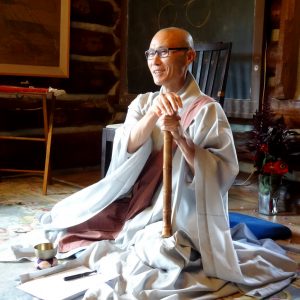
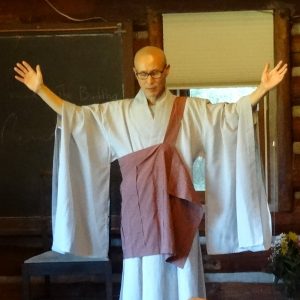

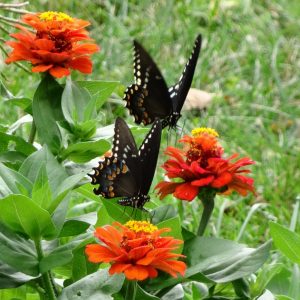
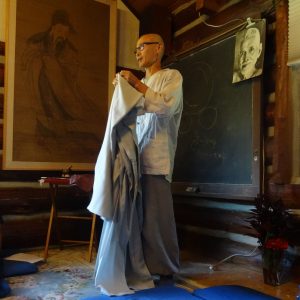

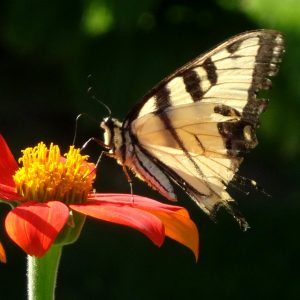

Dear Elaine,
How peaceful this meditation is, bringing quietness to the reader and a lovely sense that “all is well”, despite our noisy world.
You are a wonderful photographer as well as writer, your butterflies are beautiful! I could not have named them and am grateful for your naming. (I don’t know how to make this print larger. Hope you can read it.)
With thanks for many other writings as well as for this particular one.
Love, Helen
It’s nice to hear from you, Helen. Thanks for your encouraging words. It’s easy for me to have an agitated mind in this noisy tumultuous world. I enjoyed experiencing and writing about peace.
Your print was the right size, but my blog program (WordPress) standardizes print size. I’m co-leading a bereavement workshop at Hospicare called “Gathering the Pieces,” October 15, 10 am to noon. I can give you a ride if you’d like to attend. Just send me an email when the time gets closer. I can also send you more information about the workshop and Hospicare will send out announcements in September or in the October newsletter.
Watching the vastness of the ocean alone , see forever, nothing to look at or think about. Looking at mountains and meditating on the farthest points, the very tops
Beautiful images and experiences, Patt. The trick for me is to give myself time and space to experience the peace that’s always available.
Thanks for the reminder Elaine to take a moment and do nothing but take in the beauty of the silence and nature’s gifts.
The butterfly photos are gorgeousl I just adore butterflies.
I’m happy to know you’re taking in some well needed sips of inner peace. Namaste my friend. 🙂
Once in a while I get quiet–and once in a long while it rains. I was awakened by lightening and thunder last night, the most beautiful fireworks I could imagine and over an inch in the rain gauge this morning. The world is greener already. I hope you see butterflies where you live, but I’m happy to share photos. (Who could stop me?) I’m lucky they love my flower garden. Peace to you and to all of us.
Thank you Elaine. And yes, I do see butterflies sometimes. I do need to get out more. This is for certain. 🙂
There must be butterflies in those parks in Toronto. I googled and saw there’s a butterfly festival in Toronto. Then I saw the Butterfly Conservatory. Hmmm…
Lovely, Elaine.
I would love to come sit with you. I miss you.
I miss you, too, Janet. Come sit with me. It was a pleasure to be with Sunim’s inner peace. I went with my begging bowl and hope I brought a little home.
Lovely Elaine. Thank you!
Thank you, Peggy. I look forward to sending this piece to Sunim and his translator Nami. It was wonderful to be in Sunim’s presence and to be asked to take photographs for the Korean Buddhist magazine. I love taking photographs (as you know) and didn’t have to be concerned that I was taking too many. They wanted all of them.
Lovely post. If there’s one thing I’d love to do but am afraid to try, it’s meditation. I worry that I won’t be able to turn my mind off and I’ll do it wrong. My pastor has told me about a retreat she goes on where the attendees don’t speak for an entire week. She said it’s incredibly revealing and inspiring. Your post reminded me of her retreat experiences. Thank you! Maybe I’ll give meditation a try sometime soon.
Thanks so much, Amy. It would be a lot to go from no meditation with concerns about it to a week of silence, but maybe full immersion is right for you. You’ll know. Pema Chodron is an excellent teacher when it comes to tossing out our thoughts about a right or wrong way to meditate. In 1970, I began with 10 minute meditations on the breath and added 5 minutes a week until I sat for 45 minutes or more. Now I usually sit about 30 minutes, but I consider my whole life to be an opportunity for practice in awareness and quiet mind. I especially need that approach when I’m living in frantic mind–so I repeat a prayer/mantra while I drive, when I’m scared, when I’m nervous, any ol’ time at all.
Water. Watching water. And the wildlife that is attracted to it. I can sit for hours by my pond and feel the peace. Yes, my mind is often still churning on about all the things that need doing. But when I sit with my dog on the deck overlooking the water, something in me melts.
You have your “magic” spot, Robin. We can feel peace deep within and let that churning mind go chugging along by itself. It isn’t going anywhere anyway.
I felt peaceful just reading this lovely meditation. Like you, for me nature is a major inspiration for meditation. As I sit on my porch here in the Smoky Mountains and watch the rain softly falling, I feel my heart beat slow down and my mind settle into a calm, meditative state. Realizing that I too am part of nature makes me feel part of everything.
Thank you for the wonderful image of Smoky Mountain peace. Before the days of television (or air-conditioning), we sat outside in the evening when I visited my grandparent’s Missouri farm. The chores were done or would wait until morning. We shared a moment of rest and quiet in the shade of the catalpa trees.
Thank you Elaine, Jean took the words right out of my mouth. I felt peace just reading your post, so a huge thank you. Open-ness, light, form, breath all beautifully expressed in the images –
I have such a monkey mind – endless chatter. Meditation is the only way to quiet it. I do this first thing in the morning usually. There is no reason why I couldn’t do it more often and just sit quietly absorbing nature on my own home turf. I always feel I have to be elsewhere –
A little something rubs off when we’re around someone who has a quiet mind. My husband taught with Sunim many years ago because they were both interested in Buddhism and Science. Sunim made a few trips from the west coast to be with Vic and try to heal him, but it was not to be.
Seems like we all have monkey minds. A friend told the philosopher-sage Paul Brunton that she kept thinking about this and that and couldn’t stay focused on meditation. He said in his wry way, “That’s the ego’s job.” In other words, we should expect monkey minds from our noisy egos. Pema Chodron has helped me laugh at myself. What else can we do?
Sunim and butterflies, lovely Elaine. I will never quite see him in the same way now. His robes like wings, his delicate yet certain approach to life. I hope to see him again someday.
For me peace comes as the fog rolls in through pines and cypress, hushed and heavy with moisture. It comes sitting in soft sand while listening to the waves crashing endlessly on the shore. It is near when I hold my old mother’s hand and feel her heartbeat through her thin fragile skin. My mala reminds me of it which is why I carry it with every step.
Peace is illusive yet pervasive.
It heals and makes wild joy feel more wild and deep sorrow infinitely heavy.
It holds everything
and releases all.
I agree with Helen, your writing brings a sense of “all is well despite our noisy world”. What a gift.
PS There is something fabulous about the picture of Sunim sitting with his staff. The contrast of the stiff staff and his robes loosely spreading around him. He is like a mountain and a waterfall all at once.
I agree, Lauren. I loved the contrasts in this image. It’s hard to get a photo of him smiling. I was asked by an editor from “Modern Buddhism in Korea” to share photographs of Sunim. I went for it and took 200 photos throughout the day. I tossed the worst and gave the editor 100 images. He’s photogenic. Since I have lots of trouble sustaining focused hearing when acoustics are poor and English is heavily accented, watching is a great way for me to stay focused. (I didn’t take photos during meditations.)
Thank you, Lauren. You wrote: “Peace is illusive yet pervasive. It heals and makes wild joy feel more wild and deep sorrow infinitely heavy.” I now recognize that the first two years after Vic’s death were a time of deep peace, even as I wept and struggled with a broken heart. There was also an abiding calm quiet within and it held me together as other forces pulled me into pieces. I know you know this mystery through being with the dying, the grieving, and the frail aging. Thank you for your fearlessness in the face of Vic’s death and my grief.
It’s easy to momentarily forget the mess the world is in when I stay on my land and watch nature. We had a big thunder-lightening storm after midnight and an inch of rain. What a blessing. May it rain on the fires in California and everywhere.
What a lovely post, Elaine! I was just reading about the mandala and its significance. In meditation, it is used to calm the mind. As the meditator focuses on the intricate pattern and follows the colorful path of the image, he becomes absorbed in its complexity and loses his perfunctory thoughts. There are so many “mandalas” in nature: beautiful butterflies, gardens, etc. What a privilege to get lost in these things, if only for a few moments!
I agree, Rica, and love your explanation. Thank you. I’ve worked with mandelas and walked labyrinths. I’ll never forget a one-evening class given by my first teacher and founder of my meditation center in the 1970s. The idea was that, as questers, we first dwell in a guru mandala with the outer teacher as the center and eventually our higher Selves or Souls take the center. Venerable Sunim has a Zen approach of looking into mind. He also teaches Buddhist philosophy, yoga, and tai chi as part of practice. In recent years, I’ve follow breath and stayed in touch with body. Mantra comes to my rescue every time when outer circumstances are upsetting or just noisy. Wherever we find peace, it’s a good thing.
A wonderful post, Elaine, and one that helped me breathe deeply after a couple of overly busy days. I need to do more meditation. When I sit I hear the ocean in sync with my breath. In and out, in and out. Washing the shore with fresh water, my mind empties and I’m happy.
Joan, your ocean scene invites me to sit and be part of nature. It’s all too easy for me to choose a busy life of doing and forget to give enough time to just being. I’m trying to find a better balance, but this is an old issue for me–and for our culture. Meditation is a wonderful daily reminder of a more peaceful way.
What a great write, thank you so much for sharing this experience with us. Your insights and photos brought me great joy this morning.
Thank you, Victoria. I’m so glad it brought you joy to read it, because it brought me joy to be there and to write about it.
This is such a beautiful post. I have been inspired by Buddhism for years, and meditated in temples in South Korea when I taught English there. Your images and descriptions are lovely! Thanks for this post.
Thank you, Tricia. I became interested in Buddhism in the 1960s as a student studying Southeast Asia and China, but became more involved after meeting the Dalai Lama in 1979. I’m interested in many traditions and am not formally a Buddhist. I spent in Taiwan with Chinese Chan Buddhist nuns at a large monastery there. I’m writing about that experience now so felt especially connected with Sunim’s teachings about Amita Buddha (called Amitoufu in Taiwan). I didn’t know he would focus on a practice associated with Amita, but the world is full of sweet surprises and connections.
I’m drinking in both your words and these beautiful images while holding a cup of tea in my hands, Elaine.
I’m also reading Barbara Bradley Hagerty’s book Life Reimagined. She talks about research done on meditation and admits it’s hard for her to sit.
It’s hard for all of us, I think.
But very worthwhile.
Go deep.
Tea is a perfect accompaniment to this post, Shirley. I don’t know enough about Korean culinary habits (other than kim-chi) to know if they drink as much tea as Chinese and Japanese. I imagine so. I don’t know the book you mention, but you’ve never led me astray, so it’s on my list.
It’s hard to sit and stop “doing.” I feel fortunate that I meditated most days with a meditation master (our first teacher, met in 1967 and he died in 1984). That consistent daily practice created a habit. It’s harder now than it was then, but I tasted quiet in those years. Yes, silence is worthwhile and goes deep if we’re persistent, no matter what our background. I love how mediation is being taught in hospitals, prisons, schools, and community centers. There is a weekly meditation at the residence where my mother-in-law lives. Our culture desperately needs it.
I struggle with stillness as well. Also, I struggle with my chattering “monkey mind” when I meditate.
I would rather run than walk, and stop to breathe in the stillness when I’ve pushed myself to my limits. It’s tricky to learn to sit and just be.
Thank you for posting another wonderful blog, Elaine!
Thank you for commenting, Caroline. I’ve worked on creating stillness in meditation and life for nearly 50 years. It doesn’t come easy, but there are those unforgettable moments when monkey mind grows still. So far, for me, just glimpses and then the monkey mind is back, chattering, wanting something, fretting about something. It’s powerful to be around a person such as Sunim who can watch the sunset or eat a cookie or sit on meditation cushions and emanate a sense of peace and a touch of humor about our human chaos.
Thank you, sear Elaine, for reminding we should do nothing for a moment but take in the beauty of the silence and nature’s gifts.
Your butterfly photos are wonderful!
Luisa, I need to remind myself, but I’m doing better than when I was younger. I had a “do nothing” day today–hiking with my dogs, feeding butterflies, photographing butterflies, talking with my son on the back porch for a while. Thanks for letting me know you enjoy the butterfly photos. I find myself wandering outside to look at the gardens, letting other things go.